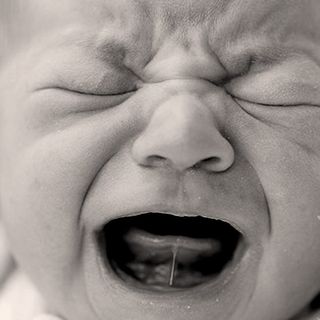
Men and Women Remember Physical Pain Very Differently
“I’m not very proud of my gender,” says a senior author of the study.

After a physically painful experience, men’s memories can exaggerate the pain, which makes them more stressed about and sensitive to pain in the future, researchers at McGill University and the University of Toronto, Mississauga, have found. Women, on the other hand, handled pain like champs. So much for the weaker sex.
The conclusions were reached after conducting experiments on mice, and confirmed by similar experiments with humans. Researchers say their finding changes the game when it comes to treating chronic pain. It also adds to the growing body of evidence around gender differences in pain.
“We were blown away when we saw that there seemed to be the same differences between men and women as we had seen in mice,” says the study’s senior author, Jeffrey Mogil, a pain specialist in McGill University’s department of psychology and Alan Edwards Centre for Research on Pain. “There was some reason to expect that we would see increased sensitivity to pain on the second day, but there was no reason to expect it would be specific to males. That came as a complete surprise.”
Related on The Swaddle:
Some Doctors See Pain As Just A Symptom of Being Female
The two-day study was designed to explore what role memory plays in the experience of pain. The first day, in the human study, male and female participants experienced low-intensity pain caused by heat on their forearm. (On the first day of the mouse study, male and female mice experienced the same sensation on their hind paw.) The men and women rated the level of pain from 1 to 100, ad researchers measured how quickly mice moved away from the heat source.
Researchers then administered a much more intense pain to all participants: The men and women each wore an inflated blood pressure cuff while performing arm exercises for 20 minutes, which more than 90% of participants found agonizing, rating it at a 50 or higher on the 100-point scale. (The mice received a vinegar injection that prompted a severe stomach ache.)
On day two, the tests were repeated in the same manner, with participants remembering and rating the prior day’s pain before undergoing the same tests. Some experienced the same tests in the same environment, while others underwent them in different rooms (or, in the mice’s case, cages).
The researchers found that men, and male mice, when in the same environment as the previous day’s painful exercise, rated the pain higher than they had the previous day, and higher than the women in the study. Male mice returning to the same environment as the previous day’s painful exercise also displayed a heightened pain response.
“This is an important finding because increasing evidence suggests that chronic pain is a problem to the extent that you remember it, and this study is the first time such remembered pain has been shown using a translational — both rodent and human subject — approach,” says the study’s first author, Loren Martin, an assistant professor of psychology at the University of Toronto Mississauga.
The study also adds to a growing body of evidence that suggests men and women experience pain differently. As The Swaddle reported last year, research is increasingly showing that the biological mechanisms behind pain are very different between men and women — but so is the way society interprets that pain. Men and women describe pain differently, and the way medical practitioners interpret those descriptions is often skewed:
Women tend to use more words to describe pain, and use “more graphic language than men, and typically focused on the sensory aspects of their pain event.” They tend to speak in more medically approved language, using more descriptors from the McGill Pain Questionnaire. By contrast, men were more succinct, used “less descriptive language, and focused on events and emotions” (interpreted by some as recalling the injurious event “more objectively”).
Mogil and team’s finding suggests that men’s descriptions of pain may not always be as objective as previous believed, opening up the possibility for further study — and perhaps a more nuanced medical appreciation for gender differences in pain.
“I think it is appropriate to say that further study of this extremely robust phenomenon might give us insights that may be useful for future treatment of chronic pain, and I don’t often say that,” Mogil says. “One thing is for sure, after running this study, I’m not very proud of my gender.”
Liesl Goecker is The Swaddle's managing editor.
Related


How To Boost Executive Functioning Skills In Kids Aged 5 to 7
